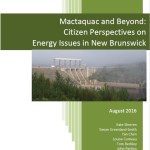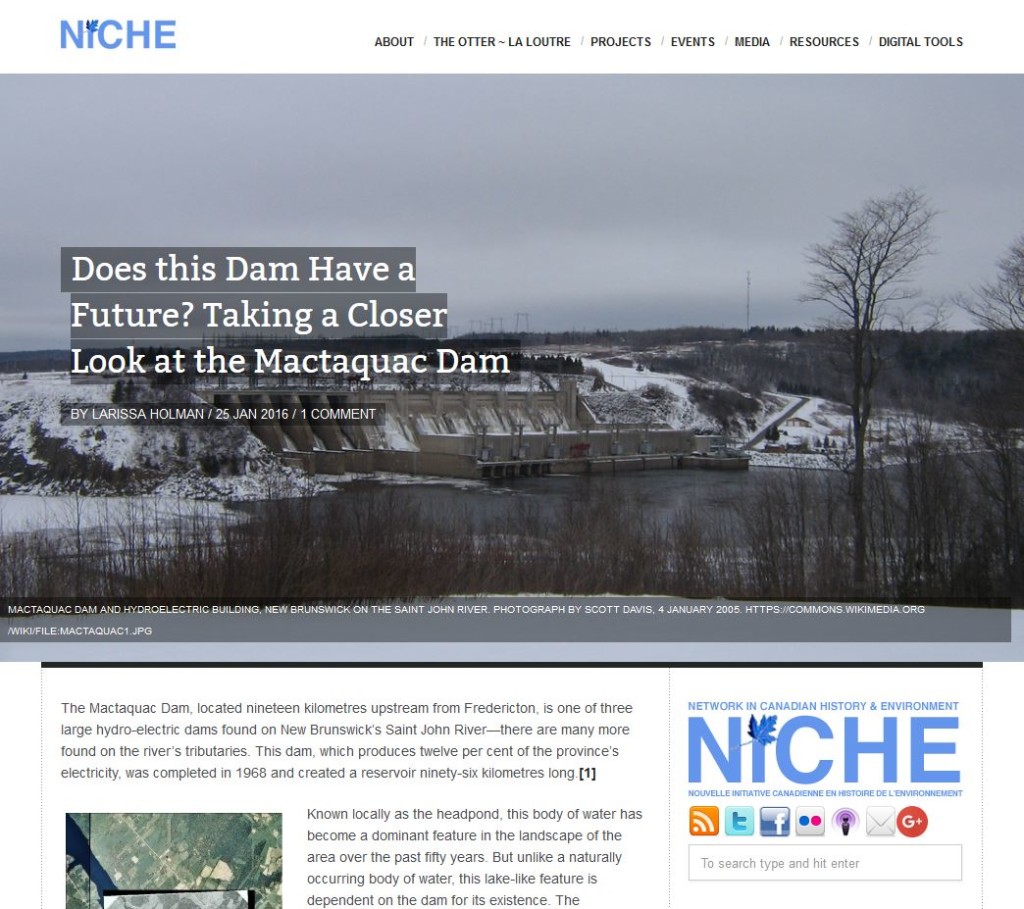Coincidentally, given the previous post, the last paper out of research that Energy Transitions in Canada undertook on the Mactaquac decision came out today in Water Alternatives. This new open source paper features both qualitative and quantitative analysis of a randomized proportional survey of 500 New Brunswickers implemented back in 2014, before the official public engagement campaign began in earnest. We compare the results of that survey against insights from our qualitative fieldwork with local residents, undertaken in 2013-2014. The paper describes how and why the local and provincial discourses came to align. It is part of a special issue on dam removal, so thanks to co-editors Chris Sneddon, Régis Barraud, and Marie-Anne Germaine for their hard work on the collection.
Tag: headpond (Page 1 of 2)
McNally’s Ferry – erstwhile town and transportation infrastructure on the Saint John River, pre-Mactaquac Dam and today.
Congratulations to MREM alum Larissa Holman, for news that our Before the Mactaquac Dam storymap was selected as ESRI Canada’s App of the Month for October (French version here). Larissa worked with me back in 2015 supported by Energy Transitions (Parkins PI) SSHRC funding. Larissa is now working with Ottawa Riverkeepers, and reports that her job:
… is a nice mix of keeping on top of projects, investigation work when someone reports pollution or odd activity on the river, working with some really wonderful and knowledgeable volunteers and the occasional canoe trip or boat ride out on the river.
A great alum story for a lovely fall day.
Last week I visited my family’s lake cottage in New Brunswick, and did the usual dash in to the nearest town, Nackawic, for food and drinks. I grew up in Nackawic, and left in 1991 for university and beyond. After 26 years it is often an uncomfortable outing, undertaken with stealth: I’m always worried I’ll see someone I should know but whose name eludes me. This trip was happily anonymous. I was able to linger in my annual nostalgia trip: peering in the window of the bowling alley (which seems to have shut down without removing its Open sign); popping in to the post office where I was a frequent customer in the days well before digital (sending letters to many penpals, collecting stamps , and returning Columbia House monthly choices to avoid billing).
At the checkout of the grocery store, I spied a headline on the regional paper, the Bugle-Observer, “Good News for future of Forest City Dam – maybe” (sadly paywalled). Anything dam-related catches my eye, so I grabbed it to read at the cottage, which has no TV or internet access. The future of the small dam that holds back the enormous East Grand Lake on the border between Maine and New Brunswick at Forest City is at question, motivating owners of the 2,000 cottages around its perimeter to organize to keep the water levels up. Under the fold was another story related to dams, also written by Doug Dickinson. A fellow named “Hoot” was being inducted into the Atlantic Salmon Hall of Fame, and he “still names his favourite fishing spot as the long-gone Hartland pool” on the Becaguimec Stream that drained into the St. John:
That all changed after dams were constructed on the St. John River. Smith said the salmon fishing was still good after the Tobique Dam was built, but declined after the Beechwood Dam was finished. The Mactaquac Dam put an end to the Hartland Salmon Pool.
One of my new research interests is the use of digital archives to understand cultural change in regions that have faced infrastructure change like hydroelectric dams and related inundation. Newspaper archives is one of those I’d like to explore in this way, so we can look back and understand how host communities are affected over time, and how they adjust. This newspaper would make for an interesting case: 50 years later dams are still front page news. What else hasn’t changed? The third front-page article: Meet Miss New Brunswick 2017″.
I was in Moncton for a meeting with DUC on Friday when the What Was Said report arrived in my email inbox. This report is a compilation of the stakeholder process that NB Power has so far undertaken around the future of the prematurely aging Mactaquac hydroelectric dam. They’re careful not to call it a social science report or stakeholder analysis, which is appropriate, being the combined work of Corporate Research Associates (CRA) polling and National PR firm coding. Report authors suggest that New Brunswickers voiced almost unanimous concern about the environment (particularly fish passage), taxpayer burden, local and renewable energy sources, local suppliers, and transparent process. There was a nice geographic comparison of priorities: based on self-declared postal codes those in the region were predictably more concerned with community impacts than cost; vice versa for non-residents.

The cover of our new report based on a 2014 survey of NB residents on Mactaquac and general energy issues.
They could make much more meaning from what was collected. CRA did two surveys of 400 New Brunswick residents in 2015 and 2016, before and after the public engagement, but the results are aggregated (e.g. 59% heard of the Mactaquac issue) rather than compared across years to demonstrate changing awareness. The awareness indicated here is also captured as yes/no, rather than by levels of awareness as we did in 2014, when only 7% of our 500 survey respondents considered they knew quite a bit or a lot about the Mactaquac decision. Our new report, Mactaquac and Beyond (2016), delves into the drivers of various opinions on Mactaquac (among other things), revealing an imbalanced tug-of-war between economic benefits (rebuild with power – the dominant opinion) and environmental impacts (remove – minority view), with rebuild without power a compromise option driven by landscape and cost concerns. For female respondents the issue was a local one, particularly influenced by self-judged knowledge of the Mactaquac issue, while for men preferences rode on larger principles such as conservatism or position on hydroelectricity. Risk was a driver for the ill-informed, which suggests that misinformation about the possibility of failure may be influencing results. This kind of impartial social science is important, but also usefully associates perceived impacts and preferences with options, which is something that seems to have been intentionally avoided in the NB Power process as reported.
Thematic coding is a process of generalization and erasure, and must be undertaken very carefully and by trusted parties. The data collection itself can introduce many biases as well. It was interesting to see the different themes emerging depending on the type of data collection/intervention: Mactaquaction was clearly bombed with ‘keep the dam’ comments (note there was no way to avoid multiple entries), though environment topped other modes. Yet, what is in that huge ‘Other’ category, NBP? Later analyses of community and fish passage sessions include First Nations themes lumped with Infrastructure/Transportation and Other. Those are strange bedfellows. This is a green versus green debate: climate mitigation and an adapted headpond versus fish passage and hydrological integrity. What was included in ‘environment’ and how were these sources coded? This work suggests that fish passage only came up in the formal submissions, and transparency only in community sessions, but the appendices themselves belie this.
Our first Mactaquac paper is less-than-lovingly reproduced from page 149 to 159 of the largely unsearchable scanned appendices (not including my less formal commentaries and feedback). The appendices include formal submissions from groups such as WWF, NCC and the NB Salmon Council dated as far back as January 6, 2015, including one from energy project collaborator Tom Beckley (p. 173-178) about his multiple relationships with the dam landscape as landholder, taxpayer, Local Service District committee member and scholar. His piece is a nice microcosm of the complexity of the Mactaquac decision. None of these thoughtful submissions is given any response. Appendix E, the Public Correspondence Snapshot, goes back even further, to December 15, 2014, and is filled with rich stories and important questions (all anonymized). The parts we can see scanned sometimes include quick replies that suggest an answer to the proffered questions will be forthcoming (see below): how powerful it would have been if these submissions AND answers were posted online as they arrived! As mentioned in our recent Mactaquac paper, this could help bring the conversation from “me” to “we”.

A typical answer from NB Power on a public submission on Mactaquac submitted via the stakeholder engagement website (Appendix E p. 234).

One public submission from a high school student demonstrates misinformation about Mactaquac (Appendix E p. 246)=.
One submission in particular caught my eye, from a student at Nackawic High School who believes that the decision has already been made not to rebuild (p. 246), asking questions to complete a Journalism class assignment. My first thought was… since when does NHS offer Journalism? My elective options in 1989 were typing and child care. But secondly and clearly more salient here: the fact that such misinformation existed in April 2016 (and perhaps still exists), likely transmitted by a parent or teacher, was disturbing. Unlike other submissions, there is no evidence from the Appendices if the student ever got an reply – even poorly informed questions should be addressed, maybe especially poorly informed ones.
So what now? What will happen with What Was Said, and how will it feed into the decision? When will we hear about First Nations consultation, though at least one group has come out for removal? When will we get more details on options 3 or 4, comparable to that available for 1 and 2? What about real estate analyses? Impact on the river ecosystem? The NB Power and NSERC funding to the Canada Rivers Institute so far has generated lots of data, available through their ArcGIS online storymap, but a little preliminary synthesis would be great.
I was pleased this week to learn that Dalhousie MREM graduate Larissa Holman, who was a summer intern with the Energy Transitions in Canada project, has a piece about her Mactaquac storymap in an online publication by NiCHE (Network in Canadian History and Environment). The article, Does This Dam Have a Future?, recounts the process of creating the storymap and the role that it was designed to play in the ongoing public consultation process around the New Brunswick dam’s future.


